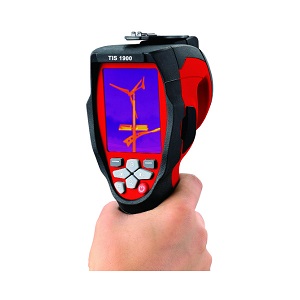A thermal imaging camera is used as a form of non-contact testing to detect regions of temperature. It is most popular in electrical safety testing for inspection, testing and maintenance of electrical installations. It can detect overheating components and thermal insulation gaps to identify safety problems and where heat energy is being wasted.
What does a thermal imaging camera look like?
Most thermal imaging cameras look like a type of gun. It is a handheld instrument which the user holds and activates using a trigger in the handle. There is also a large LCD display screen at the top which is used for displaying the infrared images and taking temperature readings. On the reverse side of this screen is the sensor that is pointed at the area or temperature region under examination.
How to use a thermal imaging camera
A standard thermal imaging camera such as the TIS 1900 from Test Instrument Solutions displays S, H and C readings constantly on the display screen. So these are the readings that will give you an accurate temperature as you move the camera around.
S - is the centre spot temperature – the temperature at the central point you are directing the sensor to
H – is the point on the screen with the hottest temperature
C – is the point on the screen with the coldest temperature
These figures will change in real time as you move the camera around and hence the sensor is pointing at a different area or temperature region. You can capture an image of what the screen is displaying at any point, and by holding down the trigger you can take a video and voice recording also, which is saveable and downloadable. You can change the setting to take standard digital photos of an area, which is useful for then referencing and comparing to the thermal image of the same area.
A thermal imaging camera will detect the surface temperature of the first object or surface in its line of sight. So you need to be accurate in how you direct the camera and its sensor to ensure you are capturing the areas or items you need to. The distance at which you can get reliable readings also depends on the resolution of the camera, ie. how many pixels it can pick up. The higher the camera’s resolution the more pixels it will pick up and the higher the accuracy you can expect. Just like our human vision, the further away from an object the camera is, the lower the accuracy will be, but most thermal imaging cameras, including the range supplied by Test Instrument Solutions, have very good resolutions for high accuracy. And in terms of distance away from the subject, the general rule is that the area or item you are trying to measure should overfill the spot-size measurement tool on the camera’s display screen to achieve a suitable accuracy.
Other settings on a good quality thermal imaging camera
Other settings on the TIS 1900 include showing the infrared vision on the display screen or a normal camera vision, or a fusion of the two. You can also take emissivity readings of different surfaces for true accuracy, so the camera will give you different reflective temperatures for water, stainless steel, aluminium, asphalt or concrete, depending on the type of environment you are working in.
It is better to use a thermal imaging camera at night, because the ambient temperature is lower at night and so is the core temperature of otherwise unheated objects. Even on relatively cool days, the sun’s heat is absorbed by buildings, materials and equipment and so in the evening the thermal imaging camera will be able to display readings with a better contrast and accuracy, ie. without interference from other surrounding objects or surfaces heated by the sun.
Most thermal imaging cameras should come with accessories such as a carrying case, leads, SD cards and software for downloading images and videos and a calibration certificate.
Video Demonstration
Find out more about the TIS 1900 thermal imaging camera in our video below:
Please note that this section is for information purposes only. Anyone using equipment referred to in this section must be suitably qualified and/or experienced within the respective field. If in doubt before use, please consult a qualified electrician or engineer & thoroughly read all instruction booklets.